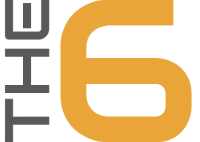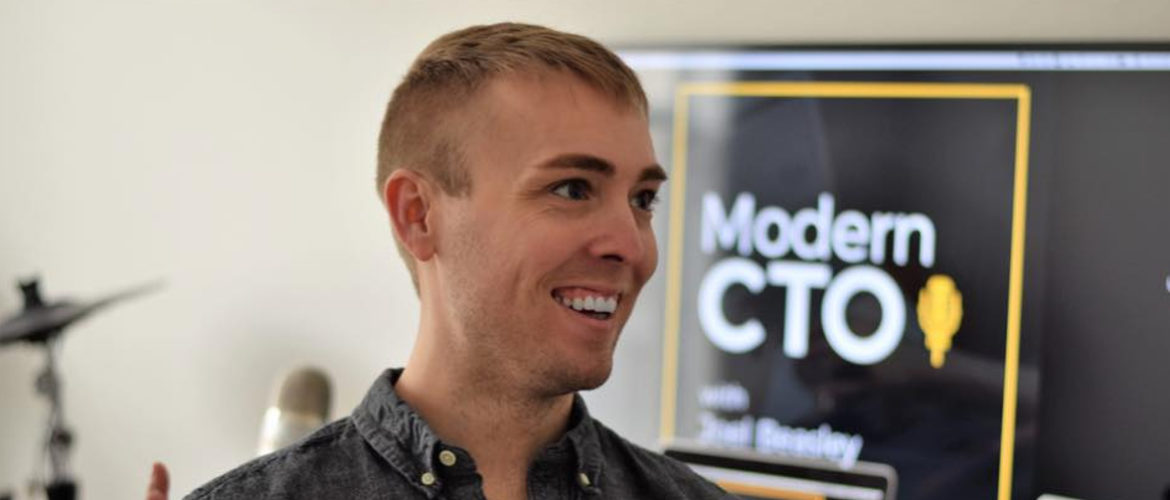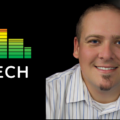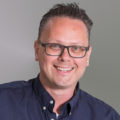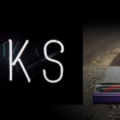Podcast: Play in new window | Download (Duration: 31:59 — 25.9MB)
Subscribe: Apple Podcasts | Google Podcasts | Spotify | Stitcher | Podchaser | Email | TuneIn | RSS
Joel is an MIT Educated, family first workaholic. Joel loves his k9 friends Ted, Teddy and Bently has a beautiful wife Michelle. Recently Joel has welcomed a brand new addition to the family, his first child, a daughter, Ari. Joel has a passion for writing clean object oriented code with a heavy emphasis on services. Single Responsibility Principle, Low Coupling and High Cohesion are just a few of the important design principles he employs.
Transcript
Jon Ash: Before we get started would you tell us a little bit of backstory about yourself? How you got started, and what motivates you?
Joel Beasley: Yeah, for sure. My father was an engineer, he came out of the Air force. He was putting the GPS systems into the B32 stealth bombers in the 80s. So that’s how he got his education. Then he came out of the Air force, started doing freelance work. And then my mom had two other kids. We have three kids. And she said, “Take this one with you to work, so he doesn’t cause any trouble here at the house.” So my dad would take me to work with him and give me smalls tasks to keep me busy. And later I realized he was just trying to buy himself time to get work done by having me go chase down items, and memory, and things like that, and solder different parts together.
Joel Beasley: So from there I got really into technology, wrote code all the way up through high school. After high school had some successful projects in the real estate space, and fitness, and then in accounting, and personal financial management. Met some investors, started seeing other people make the same mistakes I was, so I started sharing with them. But there wasn’t enough time for me to share all my advice, so I learned about blogging. Well I know about blogging, but I learned about, you write when you can’t tell everyone everything all the time.
Joel Beasley: So you can just say, “Hey, take these collections of writings if you need them, here you go.” So that turned into a blog which turned into a book. From the book I wanted to make sure I would get flamed publishing nonsense, so I started sending copies of it to different CTOs. And from friends, past people I had acquaintance with, and then some just popular CTOs. And they started to write back and we ended up having these phone calls. And that turned into recordings of the phone calls to share on a mailing list.
Joel Beasley: And then someone was like, “Hey idiot, it’s called a podcast. Stop sending me MP3s of your conversations.” That’s when I learned that a podcast was more than just an app on the iPhone. And we started a podcast, and then it grew really fast. Now we’re just sharing and helping people everyday. I like it.
John Callaway: So the initial project and book was modern CTO. You want to tell us a little bit more about that?
Joel Beasley: Yeah. Those conversations, there was about 12 recurring conversations. Please don’t quiz me on them now. One a big one was like, spaghetti code MVP epidemic. Everybody was writing some really bad spaghetti code. And they were making the excuse of, “Oh, it’s an MVP, I can write really bad spaghetti code.” I said, “There’s only two reasons why you write bad code, either you know how to write good code and you choose to write bad code, or you just don’t know how to write good code.”
Joel Beasley: And both of those things suck because they’re both fixable, right? You can learn how to write good code, and then just reduce the scope. And then have a moderately quality base that’s not spaghetti code crazy. And obviously there’s a spectrum of spaghetti code too. But like, Ben Orenstein’s spaghetti code’s a lot different than a first time engineer.
John Callaway: I saw you tweet out that particular quote … or someone else had tweeted out that code and attributed it to you, and I could not agree more. That sums up my feelings exactly on writing bad code.
Joel Beasley: Yeah. So that’s what the book was. Just a couple … about 12, 15 topics that had come up a lot. And I just shared them, and I also shared my personal stories inside of that. I like the storybooks, so I wrote it like that. Tried to keep it short. It’s like a 3-4 hour read.
John Callaway: And you’ve had a number of notable CTOs on your podcast as well, are there any particular interviews that you like more than others? Or any episodes that you would recommend to others? Or ones that you’re particular proud of?
Joel Beasley: Yeah. Recently, I think the NASA episode was pretty cool. That guy was really nice, Douglass Terrier. Microsoft was a cool one, Kevin is great. The interesting thing about the podcast that we’ve done, like 230 or something, but only about 90 have released. So I’m not always exactly sure which ones have been released when I’m having these conversations. Because Jake is in charge of that.
Jon Ash: So this has sort of turned into a bit of a business for you? This podcast thing? Is that sort of what I understand?
Joel Beasley: Yeah, unintentionally. So the original intention was, “All right, let’s share with people.” And then when I realized I was gonna be spending money, right? Because I’ve put just over $250,000 of my own cash into it, into the podcast. So when I realized that it was useful and people liked it, I put my own money into it. And then I realized I had to have some reason to put money into it. So the original reason was, “let’s share with people. Let’s develop a network of really great CTOs,” because you’re the average of the five people you spend your most time with, right?
Joel Beasley: If all I’m doing every day is talking to these great CTOs and then bringing value to the audience, then I’m gonna leverage that into a future job, because networking’s super important in business even as a programmer. At every stage of the business it’s so important. That was my financial justification for putting the money into it. Then about four months into it a few guests had come on the show, and they said, “Hey, our companies are growing from 30-90 engineers, or from 90-500 engineers. We hear you talk on our commutes about exactly … with these technology leaders, how do we take those thoughts and then transmit them into the brains of our engineering leaders?”
Joel Beasley: And I said, “I have no idea. I don’t know. I don’t know how we will do this.” But I spent a week thinking about it, and white-boarding it, and researching to see if anything else existed. Because I refer a lot of stuff. People ask me, they’re like, “Oh, what do you like for API documentation?” Or, “What do you like for this or that?” So I will go look in my tool chest, or my gym file, or whatever it is, and I’ll suggest things. And I couldn’t find anything for leadership, and professional development for technologists other than listening to awesome podcasts like this.
Joel Beasley: So I made a basic version in Ruby, and it essentially just was the delivery mechanism for these video pieces of content that we’d do. And then I covered a couple pieces of content, and then we deployed them out to a couple hundred engineers. And they really liked them so we improved it, and gamified it, and turned it into this whole business called Leader Bits. And we essentially are just leadership in professional development for technologist. It’s like a paid version. The difference is interesting though because, here’s the thing that I found, we right now are having this conversation.
Joel Beasley: Say we’re talking about the spaghetti code MVP epidemic, we give some actionable piece of advice, like something good about implementing it. But the way I consumed content was, I’d listen to an audio book, like Managing Humans, or Measure What Matters, or DevOps Handbook. I’m just reading off my list over here. There’s 40 great things in the book, but you don’t do anything with it. You just sit there and you’re like, “Oh, that’s good, that’s good, that’s good, that’s good.” For myself, I needed it to be like meal prep. I want to implement something. It’s Tuesday afternoon, I want to do something. Where is that action that I can take that’s simple and short, and that would actually be something a great leader does so we can improve?
Joel Beasley: And came up with this idea of meal prepping the challenges. And we called them challenges. So we deploy them. Leader Bits is that. We deploy these little micro challenges to technologist in the form of this leadership program, and to do the challenges, and have community around them. It’s kind of cool.
John Callaway: Can you give us just a basic rundown, or an outline of one of the challenges without devolting too much information?
Joel Beasley: Yeah. One’s called Giving Credit. The individual will recognize a valuable action taken by another team member. And then they’ll confront them about it, talk to them about it, express that it was valuable. Then they’ll go talk to another team member and bring them into the loop about it. Because if you do that … Your team’s always watching you, right? So you’re gonna pick up on the behaviors. People don’t care about what you say, they care about what you do. If you have kids you know that. They just want to mimic you.
Joel Beasley: So we said, “Why don’t we create these actions that the leaders can do them? And then their team will begin to mimic them, and we’ll report on that.” We have over 70 of them. So we do one a week. We have over a year’s worth. For different levels too. One’s for individual contributors, one’s for team leads, and one’s for C-level technologists. Different challenges so you can do different things.
Clayton Hunt: Are these activities for people already in that position? Or could they also be for people who are aspiring to get to a position?
Joel Beasley: Yeah, we’ve got three levels. We’ve got lion, jaguar, and unicorn. That’s why there’s a purple unicorn on the video. But the lion one is for leveling up into leadership, moving into first-time leadership role. And then the jaguar’s for existing leaders that want to accelerate. And the unicorn is for C-level people.
John Callaway: What are the biggest challenges that you see in the industry, or with people that are looking to make those changes, or take on those challenges?
Joel Beasley: The biggest challenges with people like, as they go to level up in their career?
John Callaway: Whether or not they’re going to level up in their career, or just take a more proactive approach in their career. Because specifically with develops in the industry, there are a number of people that just have a development job, and may come in and do a good job, do their task and then go home. There might be adventurists that like to go to conferences, and user groups, and take on new and exciting technologies, and bring those back to their team. There might be those that are just looking to take that next step into leadership, or something.
Joel Beasley: Yeah, so here’s the biggest takeaway from, I guess, all of these interviews and everything. It’s not about intensity, it’s about consistency. That’s the truth that rings over, and over, and over, and over, and over. The people that have learned to develop and habit, and just do it as a continuous habit, improving on their own just a little bit at a time every week, or every couple days. Just setting aside a few minutes to improve, without or without our leadership program. That doesn’t have anything to do with it.
Joel Beasley: Just the humans that do that, those are the ones that go ahead. We just made content to help with that. If you have that habit you will go very far, guaranteed. And you will not see the results immediately. It’s like anything. It’s like building muscle, saving money, losing weight. It’s like anything. You just have to do it contentiously for a long period of time, and you’ll get the results. And it’s not sexy. It’s not fun. It’s not montage-style from a movie. It’s none of those things. It is these sets of semi-boring repeatable tasks that you continuously execute, and then over time people go, “Oh my God, how did you do that?”
Joel Beasley: It’s like, “Yup, I did it just by developing a habit and continuously …” And people are already doing it. You already have habits. You already have these things, these recurring things that you do in your life, and you don’t even think about them. And they compound on you every day. So the difference between the more successful people and the less successful people that I’ve talked to is, the more successful they are the more aware of their habits they are. And the better that they align the habit with their goal. So when you have a goal-habit alignment, it’s very easy to achieve the goal, right?
John Callaway: Mm-hmm (affirmative), mm-hmm (affirmative).
Joel Beasley: And it’s not more complicated than that. And I promise you this. That’s the thing. That would be the other thing. Everyone say, “Oh, it can’t be that easy.” Yup, it’s that easy. The hardest thing in life is persistence. Period. To continue to exist. To persist is the most difficult thing in our universe. Everything’s popping in and out of existence continuously. Even down on the physics level. [crosstalk 00:13:34] physics level. It is. So for you to persist, for you to carry out a vision …
Joel Beasley: And that’s a big leadership thing. For your leader to bring the team to achieve the vision. For you to continue … For you to develop yourself. For you to get yourself to the next level is the hardest thing because, boom, instantly … We have thousands of thoughts a day, you’re gonna be distracted right away. It’s hard. So I gave up on trying to focus myself, and instead I only care about one thing, and that’s the structure of my habits, and the structure of my day.
Jon Ash: Yeah, you mentioned earlier that you were talking about a person being the average of the five people … their five friends. What have you … or would you care to share, the things that have really impacted you and changed you in going through all of these interviews, and in networking with all of these people? Is this the piece that’s changed you the most? Or would you say that there’s something else?
Joel Beasley: Being around them and picking up on them. The first thing is none of them watch TV. So I drop that. I sort of create my own world. If you were to hang out with me, you would see that I get up at 5:30 in the morning and I run, so my feet hit the pavement within like, four minutes of me waking up. Earbuds in Apple … earbuds in blasting the motivational get up and get out of bed stuff by [Jako 00:14:57] or somebody. You know Jako? Yeah. He’s like, “Don’t really wanna get up and get out of bed? I get up and get out of bed.” And that’s like the first thing that pops in the head in the morning.
Joel Beasley: And I’m like, “I gotta do it. Gotta do it.” So I get up, and I’m out the door, and I’m on the pavement. And I’m like, “I’m already out here, better run.” And then I run, I get back, shower, make breakfast. On my run I flip halfway through music to content, like audible book or something I want to consume. I’m doing like, 15 minutes a day of an audible book, you’d be surprised how many books you can listen to in a year.
Joel Beasley: And then make some notes, eat my breakfast, decide what I want my objective … like, my highlight of the day’s going to be. Of course today is this podcast. So I was like, “This is the highlight of my day.” So I decide that. And I spend some time with my family. I work. I’m in the office from 7:30 in the morning till about 5:00 in the evening. And usually I take a 30 minute or an hour break to go to the gym. Because I run in the morning and I lift weights in the afternoon. And then I get home, spend some time with family, and I’m usually in bed by 8:00 O’ clock. 7:00 or 8:00 O’ clock.
Joel Beasley: So I get lots of sleep. People say, “You get up at 5:30 and you work 12, 14 hours a day? You don’t get any sleep.” It’s like, no. I actually found out I was getting too much sleep. So 10 hours is too much sleep.
John Callaway: It’s interesting that you mention podcasts and audible books. I’ve been swapping back and forth through a collection of podcasts and then an audible book, and flip-flop back and forth between the two. And you also mentioned the DevOps Handbook. I’m actually on my second straight through listen to that book. It’s a phenomenal book, and really of interest to me in my current role. But like you said, it’s difficult to take all of the nuggets out of books like these and create action items. Is that what you’re attempting to do with Leader Bits? Is that the types of things that you suggest to people?
John Callaway: Because I’m usually listening on my commute, and I’ve got to cross a bridge, and get stuck in traffic. And I don’t want to pull out a notebook and starting writing and risk myself, and my safety, and other people on the road. A lot of those thoughts are often lost by the time I get to a safe place to take some notes.
Joel Beasley: You want me to give you an example of one of the challenges?
John Callaway: Yeah, absolutely.
Joel Beasley: Dennis is the CTO of Canon. He went from CTO to Senior Vice President of Canon. You know like, the imaging and camera company?
John Callaway: Mm-hmm (affirmative).
Joel Beasley: So I had him on the show and I was like, “What’s the one thing in your career that you’d accredit your success to?” And he’s worked in all sorts of departments, mostly in technology. But the gist of it was, he continually would go ask his current leader, whoever he was responsible to the stakeholder, what would make him more valuable. Just the one thing, just give me one thing that would make me more valuable. What could I do to be more valuable to the company of the team? And then he would take that one thing and he would simply work on it. He would continuously work on it until he developed it, and that would be the only thing he would really focus on in his free time, becoming better at that.
Joel Beasley: And then he would come back and say, “This is the results of it.” He would continuously show the byproduct of it. So the challenge is called Instantly Become More Valuable. And we actually give you the steps. We break it down like, one, two, three. You can execute it in seven minutes. And essentially we tell you, “Go have this conversation with your leader, ask them this question. Come back and write the response …” We call it the Reflect DD. Because journal or diary sounded kinda lame. So I was like, “What would I want? I wouldn’t want to make a journal entry or a diary entry, but I’d definitely make an entry into the Reflect DD.”
Joel Beasley: We give the steps the question exactly what to go do, you go do it. Boom. You do it in that seven minutes. It’s a 10 minute experience every week. And then you get … We have this thing called Boomerang. You can opt into it. It’s where you get reminded about it. But then you just get the next challenge next week. And every week you’re just doing something that one of these leaders accredits their entire career to. And I figured, if you’re gonna have a habit of improving, that’s like the best possible way to do it.
Joel Beasley: You see the video of them, you see them saying this is what their success is credited to. Joel comes on the screen and gives you the steps to actually go execute it, and then you do it. CTOs will use it with their direct reports, or VTs of engineering will use it with their leader or leaders type people. And then they engage around the response. So if you were mentoring me, John, then you would see my response to that challenge, and you would engage with me.
Joel Beasley: But for advice for people listening right now, if you actually just … You don’t have to have Leader Bits to have that challenge that I just said. Actually go do it. This is one of my favorite challenges. Just walk up to your leader and ask them what skill or habit you could form that would make you more valuable. Just let me respond. Usually they’re pretty shocked. But as a leader … I’m not familiar, who’s on this … in this room right now is a team leader? Like, you lead engineers?
John Callaway: We’re all fairly high-level senior engineers, team leads, directors.
Joel Beasley: Cool. So have you ever had an engineer walk up to you, and sit you down, and ask that question?
Clayton Hunt: No. Usually they’re telling me to go away.
Joel Beasley: Yeah.
John Callaway: Clayton and I also lead the St Pete .NET meetup. [crosstalk 00:20:35] And we’ve had a couple of our members that are regular attendees come up and ask specific advice on their career, and how to take next steps. So that’s similar but maybe not exactly what you’re referring to.
Joel Beasley: Yeah. It’s something we should be doing. And if you’re this highest level, if you’re like a co-founder, CTO, you could go to your co-founder partner, or you go directly to the market, your best customers. There’s always someone to ask on how you can … what you could do to improve yourself to become more valuable. And it’s very important how you ask the question by saying it like that, too.
John Callaway: And you’ve got a development background as well. Is this [crosstalk 00:21:16]-
Joel Beasley: Oh yeah.
John Callaway: … a path that you would recommend for others? Or how did you make the transition from development into CTO?
Joel Beasley: Writing code since eight. And I’m excited because one of the Leader Bit’s customers is one of the … I’m not gonna mention it yet because we’re flying out there. But I’m excited because one of those languages I was programming in, one of those companies is currently purchasing Leader Bits. So that was really cool. But how I got there was writing code, and doing some basic stuff, then PHP for six, seven years. And a Ruby for seven, seven plus years. And then got into the whole react stuff. Had a development agency. And then when I was having my first child, Aria, I said, “Should I invest in an AI startup? Or what should I do?”
Joel Beasley: And I decided that, that’s really flimsy. AI’s really hot. You have to be really smart where you put your time, because if it’s like a five year maturity and you mis-shoot it, and you’re out of money … Or if you think it’s gonna be popular in two years but it’s really five, you’re gone. Like, you’re just dead in the water. So I figured what would be resilient would be helping other people and knowing more people. But engineering, I did lots of engineering. Got really into become a better engineer when I got into Ruby. So I’d say I was a pretty poor engineer for a while. I’ll own that one. Yeah.
Clayton Hunt: Well I guess the question then becomes, did you know it at the time, or did you discover it when you switched?
Joel Beasley: When I switched languages?
Clayton Hunt: Yeah, yeah. When you entered the Ruby community and saw the things that they were doing. Is that when it just dawned on you like, “Oh, oh my goodness. I’ve been terrible.” Or did you already think that maybe you weren’t doing all the things that you should be doing?
Joel Beasley: There’s different people in the Ruby community. Keep in mind that I started … This would be like nine … 10 years … at least 10 years ago. Easily 10 years ago when I started writing Ruby code. And it just different. They had community. PHP didn’t have community. At least however I was floating along in my journey, I didn’t come in the PHP community. But when I got into Ruby, the resources that were there to teach you to learn is like, they would teach you how to do something, but the people were so helpful and nice it would also teach you about why you’re doing it this way. With the exception of stack overflow. That place is crazy.
Joel Beasley: The blog posts were just unbelievably helpful. Lots of great people out there. And the books were really well written. When I got into Ruby is when I realized that there was ways to become better. [Martin Faller 00:24:16]. I got into introduced to Martin Faller. He doesn’t even write his examples in Ruby. I think it was [crosstalk 00:24:19] Java, or C, or something. But he was great. [Sandy Metts 00:24:24]. There was lots of great people out there.
John Callaway: It’s really exciting time to be in software development, because it seems like the communities are really being open, and collaborative, and welcoming in helping people to be successful.
Joel Beasley: Yeah, being mean got unpopular, and I was very happy about that.
Jon Ash: Yeah. A lot of our listeners are junior or people that are just kind of getting started. Do you have some specific advice that you could give to them that would help them get started?
Joel Beasley: The very first thing would be literally to go up and ask about how you can become more valuable. The second thing would be working on your communication skills. So find your medium that you enjoy. Try them all. You’ve got audio, video, the mix of the two, and then of course you’ve got writing. So personally, when I wrote my first book I had no idea how to write. Everything sounded really good in my head, and I would go freeze at the computer and get two sentences out. I learned how to write by hiring a writer. If you don’t have that ability, the two second pool from that, from my experience would be write with flow. Don’t stop yourself, just keep hitting enter, don’t care about grammar, and just try to bullet point and outline the framework.
Joel Beasley: Don’t make it sound good, just try to keep your fingers moving the whole time. And who cares if the rant goes anywhere. And then look at what you’ve done, and then you have to come back. When you write a book you have to write it like, 10 times essentially. You just keep coming back to it day after day with fresh eyes, and eventually it’ll mold into something that makes sense. But I would get really frustrated, and I tried to write a book many times. And I’d try to even just write an article. Let’s keep it even more simple for a first-time person.
Joel Beasley: I tried to write an article about my experience, my blog post, with something I did in the programming world. And I just … I would get down about it because it wouldn’t come out good, or I couldn’t get it out right. So audio recordings, just to say it out loud while you’re walking around. I tend to be a real big walk around speak audio person, and then come back and write it down. Whatever you can do to get that flow, that consciousness where it’s just firing out, it’s happening already in your thoughts, but it’s like, how do you convert that to paper?
Joel Beasley: That’s the goal. It’s not necessarily like writing a whole thing. Focus on how to get it out of your consciousness stream, and into a persistent medium. Yeah, that’s what I would say. Out of your consciousness stream, into a persistent medium. Audio, written, however you can do it. And then just keep practicing that. I’m at the point now where I can write, and my consciousness and my writing have somewhat synced up to the point where it takes me two or three revisions to get something out. I wrote an article Forbes the other day and it wasn’t that difficult. So I was like, “This is great. It only took two years of doing this all the time.”
Jon Ash: Excellent. So for people that might be looking to move up in leadership, or move to becoming a CTO, we already talked about your podcast, modern CTO, and then obviously the Leader Bits. Are there any other resources that you might point people towards?
Joel Beasley: Yeah. It’s just a continuous thing of figuring out what people need at the next level. The valuable thing what it eludes to is like, everyone has this imagination … and we don’t talk about this much at all as people, so I’m excited to talk about it here. We all always have this imagination that we have something we want the person to do. Like, we don’t tell them. It reminds me on my wife. She wants me to do these things, but she doesn’t tell me. Then she’s like, “Why did you do them?” I’m like, “You didn’t communicate.” We always have this imagination, like when you’re gonna go hire someone. You’ve hired someone before, right?
John Callaway: Yeah.
Joel Beasley: Okay. So when you go to hire someone you have this mental imagine of what you need them to be, right?
Jon Ash: Mm-hmm (affirmative).
Joel Beasley: You need them to have these skills. You need them to have enough style. But they come in and you just start looking at their history. It’s weird. We do it as humans. There’s a lot of work we’ve got to do. But here’s the advantage. Here’s the key takeaway, if you’re realizing that right now … They’re already listening to your podcast, so they already want to improve, which is step one. Congratulations, you are part of the one percent already just by listening. Now take this and leverage it. Now when you go into an interview, draw out from the interviewer what that mental image is, and then highlight and position yourself …
Joel Beasley: Granted you have skills to do the actual work. Highlight and position yourself to fill that mental image. Because they may want a more reserved person. Then highlight the more reserved aspects of yourself. Or maybe this pulling out of the interviewer will you show you that it’s not the right culture for you. So you will learn a lot. But the key takeaway would be pull out their mental image of who they want, and that’s your job at the interviewee. And then you take control, is this leadership thing. You have the control of, “Am I right for this? Is this something I want?”
Joel Beasley: Make it a decision that you’re making to work with them, and do that in every aspect. So if you’re gonna level up in any sense of the word, figure out who is above me that I need to convince to pull me up. Let’s just be real here. Forget political correctness. Who’s above me, and who can reach their hand down and pull me up? Focus your time on those people that can pull you up, and then figure out what image they have in their head of the people that they should be pulling up, and then highlight those qualities in yourself.
John Callaway: Excellent. If people wanna follow you, where can they find you?
Joel Beasley: @ModernCTO on pretty much every platform.
John Callaway: Okay. And do you have any speaking engagements coming up?
Joel Beasley: Oh yeah. Yup. So I’m at Synapse in January, which is in a month or so. It’s at the Amalie Arena. So Lightening Stadium. And it’s got all this innovation that’s happening in Florida. So they’ll pull in the military stuff from the Air force base. They’ll pull in all sorts of medical and health technology, and science stuff. We’ve got some pretty cool companies here. And then they just highlight them, so you get to see all the different innovation, all the different categories around Florida. And they go there. So it’s pretty cool.
Jon Ash: Yeah, sounds fantastic.
Joel Beasley: Yeah. I’m speaking at Synapse. If you just go to ModernCTO.IO, you’ll find them. I’m speaking at a lot of places this year.
Jon Ash: Okay. Awesome, thank you.
Joel Beasley: Yeah.
John Callaway: All right, thanks Joel. Appreciate you coming on the show.
Joel Beasley: Cool.
Links
https://moderncto.io
https://moderncto.io/spaghetti-code-mvp-epidemic/
https://www.linkedin.com/in/joelbeasleyleader
https://twitter.com/moderncto_io
https://leaderbits.io/
https://synapsesummit.com/
“Tempting Time” by Animals As Leaders used with permissions – All Rights Reserved
An International Speaker, Author, and Microsoft MVP, John has been a professional developer since 1999. He has focused primarily on web technologies and currently focuses on C# and .NET Core in Azure. Clean code and professionalism are particularly important to him, as well as mentoring and teaching others what he has learned along the way.

